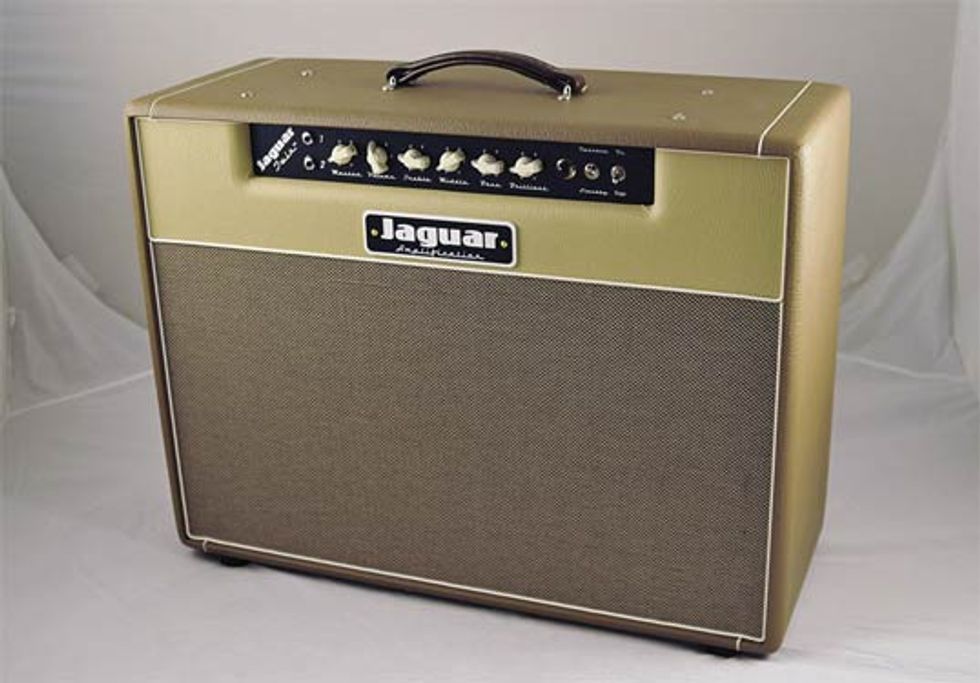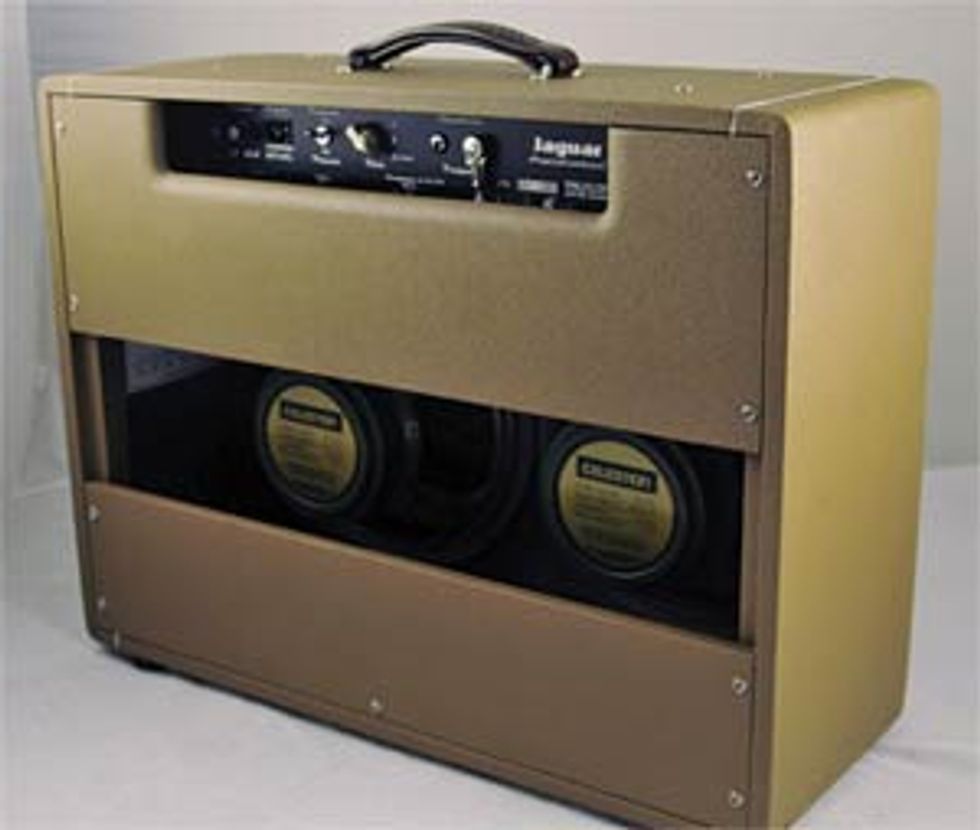Introducing the Jaguar Twin -- a tube amp that channels all of your favorite amps in one tight package.

Climate change, high oil prices and the looming threat of a potential cage match between presidential candidates Obama and Clinton notwithstanding, right now is a beautiful time to be alive – particularly if you’re an amp geek. There was a time in the not-so-distant past when amp aficionados had fairly limited choices; Fender tweed or blackface designs, Marshall head/cabinets or combos, and, for the truly lucky, one of a handful of still-functioning vintage Voxes.
The past decade has witnessed two new key contributions to the amp world; a burgeoning boutique scene and specialized amp techs. Gone are the days when the same guy who set up your guitar re-biased your amp or fixed a bad input jack. Thankfully, also gone are the days when only rockstars had their amps rebiased, with many players themselves now able to bust out their Variacs and dual-trace oscilloscopes to perform routine amp maintenance and mods.
Much of this activity is due to information being easier than ever to find via online forums, with sites such as 18watt.com offering vibrant, active communities eager to share knowledge among both aspiring and experienced amp builders. So what does all of this have to do with Jaguar Amplification’s Twin model? It’s simply an illustration of how we didn’t find them – there was no mention on the Gear Page, no glowing magazine review, not even a colleague offering, “Hey, check this amp out.”

"We found out about Jaguar the old-school way. It was while finally having the opportunity to walk the floor of the 2008 NAMM show late Saturday afternoon."
We found out about Jaguar the old-school way. It was while finally having the opportunity to walk the floor of the 2008 NAMM show late Saturday afternoon. Salted away near drum hell and the gargantu-huge Roland monolith in Hall D was the Jaguar booth, although I was perfectly willing to keep walking at that point. Barking dogs and a sore back were telling me to quickly see if there was anything cool at Roland, then find the nearest barstool. As I walked through the cacophony of a gazillion twelve-year-old “visitors” checking out drums, I heard something amazing – a warm, crunchy guitar tone, very capably cutting through the din. It was coming from about three rows over at the Jaguar booth, and Henry Clift, the man behind the Jaguar name, was busy demo-ing some tasty riffs. What was really cool was that it wasn’t so much loud – the NAMM police were there to make sure that wasn’t the case – or that it was bright or honky, as in the case of a well-known overdrive’s signature EQ. The sound just moved really well.
Needless to say, I was soon chatting Henry up, arranging for a review. The amp he ended up sending is the Jaguar Twin, a beautiful fawn and tan tolex-covered 2x12 combo, loaded with two 25-watt Celestion G12Ms. For tubes, the Jaguar uses two matched EL34s, one GZ34 and three ECC83s, all JJs. The Twin features a familiar feeling control panel with high and low input jacks, Master, Volume, Treble, Middle, Bass and Brilliant controls, followed by switches handling Standby and On/Off functions. The back panel is equally functional and straightforward, featuring two speaker outputs, an Ohms selector switch, AC input and two fuse sockets. This striped down rock n’ roll machine isn’t all barebones, though. Its ace up the sleeve is an Output Power switch offering a toneful and unique set of options: at 100 percent the Twin delivers 45 watts in Class A/B operation; when switched to 50 percent, the amp operates in Class A mode at 30 watts.
 If you’re one of those aforementioned amp geeks, you’re probably squirming around in your seat by now. Jaguar’s brochure describes the Twin as “a sonic collision of Fullerton, California and Liverpool, England.” Short and to the point, it’s also a very apt description, although I would be quick to add London to that list of locations. Acknowledging that the audible difference in loudness between the two settings is minor, the Output Power switch becomes a really powerful tone-tailoring option. In Class A/B mode, the amp is spongy and warm with a nice, clear bloom. The combination of the 13- ply birch cabinet and baffle delivers an amazing amount of bottom-end, easily delivering 4x12-like chunk. The EQ controls are highly responsive, for the most part remaining in the middle positions, leaving little doubt regarding their effectiveness for dialing in good tones in odd-sounding rooms.
If you’re one of those aforementioned amp geeks, you’re probably squirming around in your seat by now. Jaguar’s brochure describes the Twin as “a sonic collision of Fullerton, California and Liverpool, England.” Short and to the point, it’s also a very apt description, although I would be quick to add London to that list of locations. Acknowledging that the audible difference in loudness between the two settings is minor, the Output Power switch becomes a really powerful tone-tailoring option. In Class A/B mode, the amp is spongy and warm with a nice, clear bloom. The combination of the 13- ply birch cabinet and baffle delivers an amazing amount of bottom-end, easily delivering 4x12-like chunk. The EQ controls are highly responsive, for the most part remaining in the middle positions, leaving little doubt regarding their effectiveness for dialing in good tones in odd-sounding rooms. The Fullerton reference relates to the Bassman circuitry that inspired James Marshall’s initial designs, with the Jaguar behaving a lot like an old Bassman in the 100 percent output setting. Cleans are warm and bloomy; crunch sounds are glorious and seem to thrive on the highoutput, cleaner preamp settings provided with the Volume set around three o’ clock and Master at nine. What is always apparent is the ability of this amp to cut. While early Bassman heads – those with the Presence knobs in lieu of the Bright switch – tend to sound phenomenally good dirty, they also tend to become quickly lost in the mix. The Twin never faltered in this regard, always maintaining its almost magical mix of dirt and definition, yet still retaining that Bassman/JTM-45 like feel.
However, if you ever find the need for even more clarity and definition, simply flip the Standby switch, change the output setting to 50 percent, then turn back on – literally. Some of the delicious bottom is given up, as well as that nice, warm bloom, but it’s an even trade for the Liverpudlian-approved chime that’s provided. In this setting, the Master also becomes a more useful tone control, replacing some of the thickness lost when switching to Class A mode, although this amp remains about a million miles from brittle no matter the mode or the settings used. Higher-output pickups still fared best with the pre at a reasonable level and the power tubes sweating a bit. All of the typical Class A goodies reside here – clean sparkle; complex, bitchy spank; Nashville-approved overdrive – all just a knob or two’s adjustment away.
The Twin shined with P-90s, single coils and humbuckers, all retaining their tonal signatures while the Twin retained its own. Particularly tasty were the dead-on Revolver-era Harrison sparkly, light-crunch tones provided using ‘buckers in Class A mode. At the end of the day, the Jaguar Twin felt like all of the good parts of my favorite vintage Fender, Marshall and Vox designs while jettisoning everything that isn’t necessary, all while offering the reliability of a new amp with new amp bits. And good bits they are, offering Americanmade transformers and other niceties like carbon comp resistors, heavy gauge aluminum chassis and ceramic tube sockets.
The Final Mojo
We’ve been really fortunate around here to have had the opportunity to play through some truly incredible amps, and a quick perusal of our online content can very specifically spell out the amps to which I’m referring – the Jaguar Twin is on the same level as the best of them. This amp offers borderline anal-retentive, vintage Hiwatt-like construction, top quality components, and enough tonal variance to suit most any gig. The Twin plays and feels like a cool amp from a cool guy – the care that went into making the Jaguar Twin comes out via its flexible, responsive and always great tone.
Buy if...
you are looking for the amplifier equivalent of the Concorde.
Skip if...
you already have a successful relationship with your amp - this thing''s a potential home-wrecker.
Rating...
MSRP $2999 - Jaguar Amplification - jaguaramplification.com |
Our expert has stated his case, now we want to hear yours. Share your comments and ratings below.

